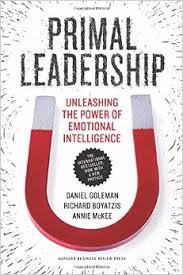Primal Leadership
 In Primal Leadership: Unleashing the Power of Emotional Intelligence, the authors examine the role of emotions in creating a resonant workplace. In resonant workplaces, employees are engaged, cooperative, and positive. This atmosphere flows downward from the leader. If a leader lacks resonance, people are probably just going through the motions of work. They do a "good enough" job instead of their best. Without an emotional connection, a leader might manage, but he/she does not lead.
In Primal Leadership: Unleashing the Power of Emotional Intelligence, the authors examine the role of emotions in creating a resonant workplace. In resonant workplaces, employees are engaged, cooperative, and positive. This atmosphere flows downward from the leader. If a leader lacks resonance, people are probably just going through the motions of work. They do a "good enough" job instead of their best. Without an emotional connection, a leader might manage, but he/she does not lead.Citing recent studies of the brain, the authors explain the neurological mechanisms of primal leadership and make clear just why emotional intelligence abilities are so crucial.
There are four emotional intelligence domains. The link between them is what creates the building blocks of great leadership. They are:
- Self Awareness. This includes recognizing the impact of one's emotions and doing an accurate self-assessment.
- Self Management. Optimism, adaptability, and transparency are discussed.
- Social Awareness. Includes a discussion on empathy, organizational awareness, and service.
- Relationship Management. Discusses guiding with a compelling vision, developing others, and building bonds.
Self-awareness is the key to leadership development. But, the higher up the ladder a leader climbs, the less accurate his or her self-assessment can be. The authors found this in analyzing 177 separate studies that assessed more than 28,000 managers. Most leaders don't receive important feedback to learn how they are performing. People within the organization don't want to be bearers of "bad news" about company morale or be critical of the boss's leadership style, so they simply go along. The authors found that the most effective leaders actively sought out negative feedback as well as positive and thus understood the need of a full range of information.
From Chapter One:
Leaders have always played a primordial emotional role. Throughout history and in cultures everywhere, the leader in any human group has been the one to whom others look for assurance and clarity when facing uncertainty or threat, or when there’s a job to be done. The leader acts as the group’s emotional guide.
In the modern organization, this primordial emotional task - though by now largely invisible - remains foremost among the many jobs of leadership: driving the collective emotions in a positive direction and clearing the smog created by toxic emotions. This task applies to leadership everywhere, from the boardroom to the shop floor.
Make sure to check it out today!













